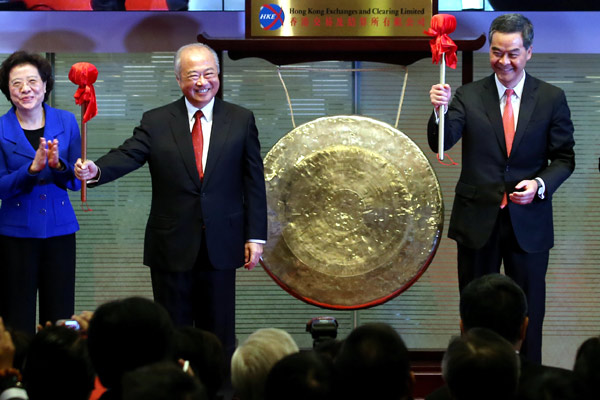 |
|
Hong Kong Exchanges and Clearing Ltd Chairman Chow Chung-kong (second left) and Hong Kong Chief Executive Leung Chun-ying (right) prepare to hit a gong during the launch ceremony of the Shanghai-Hong Kong Stock Connect, at Central in Hong Kong on Monday. [Roy Liu / China Daily] |
The pilot stock trading plan linking Shanghai and Hong Kong has achieved its intended goal, the securities regulator said on Friday, responding to concerns about poor market demand in the first trading week.
By the close of trade on Friday, total trading value reached 29.1 billion yuan ($4.75 billion) under the Shanghai-Hong Kong Stock Connect program. Investors in Hong Kong traded 25.2 billion yuan of Shanghai-listed shares while the mainland investors bought and sold 3.9 billion yuan of Hong-Kong listed shares, according to the China Securities Regulatory Commission.
The launch of the stock trading scheme on Monday has been viewed as a milestone in the process of liberalization of the capital market as it enables investors in Shanghai and Hong Kong to trade shares in each other's market for the first time.
But trading activity in the first week has been disappointing as two-way capital flows have slowed substantially since the first trading day. As of the end of this week, northbound investors exhausted about 36 percent of the total weekly trading quota of 65 billion yuan while only less than 6 percent of the southbound quota was used by mainland investors.
Zhang Xiaojun, the regulator's spokesman, said at the Friday news conference that the scheme ran smoothly and orderly in trading settlement, quota control and currency exchange in the first week and has achieved its intended goals.
When asked whether the cold response from investors might suggest potential flaws in the current trading policy under the scheme, Zhang said that the regulator will continue to improve the trading system and to strengthen cross-border stock trading regulations with its Hong Kong counterpart.
Meanwhile, Zhang said that the regulator is also negotiating with international stock index providers including MSCI to push the effort of adding the mainland's equities to their global benchmarks.
A share's inclusion in global benchmarks could help raise the international profile of the mainland equities market, which will in turn attract more overseas investment, analysts said.
Investment bank Nomura Securities Co Ltd said in its report that the slow uptake in the Stock Connect scheme could be a result of investors familiarizing themselves with the new trading system and it could also be attributed to conservative northbound institutional investors who are yet to embrace the program due to operational considerations.
Charles Li, chief executive of Hong Kong Exchanges & Clearing Ltd, was quoted by the Financial Times as saying the scheme had been "hyped" by the brokerage community and he urged investors to focus on long-term impact of the scheme.
"One long-term impact of the scheme is the internationalization of the yuan," said Jing Ulrich, vice-president of Asia-Pacific at JPMorgan Chase & Co.
The scheme will not only boost the attractiveness of the mainland markets to overseas investors but will also widen the investment channels for offshore yuan, which will offer more incentives for global investors to hold the Chinese currency, Ulrich said.
